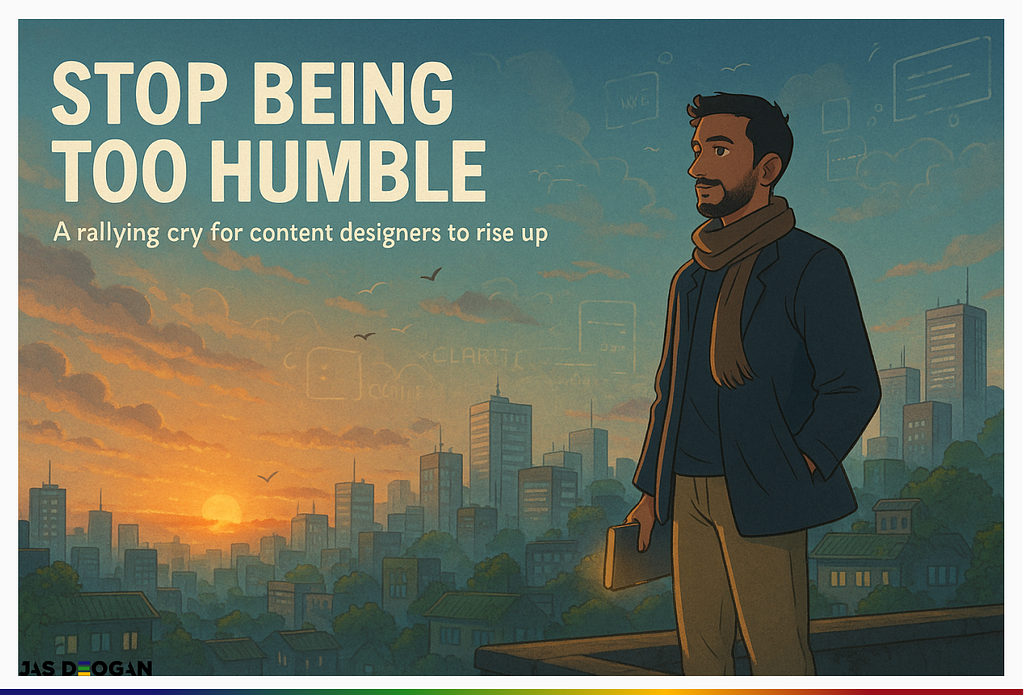Why it’s time for content designers to rise up

We’ve all heard it, and let’s be honest, most of us have lived it.
“We’ll plug in the content later.”
“The copy just needs a quick polish.”
“Can you wordsmith this real quick?”
Over and over, we watch as user journeys are built without us, conversations are designed without voices, meaning stripped from experiences because content was an afterthought.
We’re invited to the party late, asked to “make it sound good,” and expected to deliver magic in a box with half the context and none of the power.
And we accept it.
Because we’re nice.
We’re collaborative.
We’re humble.
But it’s that humility — that’s holding content design back from maturing as a practice.
And it’s time we stopped.
Who are we really
Let’s get one thing straight. Content designers are not decorators. We’re not “copy support.”
We are designers. Strategic. Empathetic. Systems thinkers. Builders of meaning, clarity and trust.
We:
- Translate complex systems into human language
- Anticipate user confusion before it happens
- Shape journeys, not just pages
- Align interface language with business goals and user needs
So why do we still feel like we’re asking for a seat at the table instead of claiming it?
It’s because we’ve been conditioned to play small. To be helpful. To fit in.
But being helpful doesn’t always mean impactful. And fitting in doesn’t always mean being valued.
Humility is not a strategy
There’s a difference between being humble and being passive.
Humility is knowing we don’t have all the answers. Passivity is acting like we don’t have any.
Humility is collaborating with product and design to build better solutions. Passivity is staying silent when something’s broken or worse, when we’re excluded altogether.
And here’s where it becomes a problem: silence is often interpreted as agreement. Or worse, irrelevance.
In a project, I led the redesign of a complex SIM activation journey that was causing user drop-off. Users were overwhelmed by too many choices, unclear language, and a confusing account creation process. By collaborating closely with the product designer, we mapped out key user scenarios and focused on simplifying the process.
We reduced the number of choices, aligned content with user expectations, and introduced an upsell service post-activation with clear context. Adopting a mobile-first approach and using conversational design, we replaced branded terms with clearer alternatives. Support messaging was also introduced to guide users and validate their choices.
This wasn’t just about tweaking words. It was content design. It was about leading with content strategy to drive business outcomes.
Take a leaf from the product designer’s playbook
Product designers weren’t always seen as strategic partners either. They earned that trust by showing up with tools, processes, and confidence in their craft.
They stopped asking for permission.
They started leading reviews.
They brought user flows, wireframes and Figma files and used them to steer conversations.
We can do the same. We should do the same.
Content audits? That’s our wireframe.
Voice and tone principles? That’s our design system.
Content-first journeys? That’s our prototype.
Use them. Share them. Build in public.
Start changing the conversation
Here’s how we shift the perception from passive contributors to active drivers:
- Speak in product language
Don’t just say “the content is confusing.” Say “this friction point is increasing drop-off at a critical conversion step.” - Own the problem space
Don’t wait for someone to tell you what needs writing. Ask “what’s the user trying to do here?” and redesign the flow if needed. - Show your thinking
Create visibility into your strategy. Invite people into your process. Let stakeholders see the why behind the words. - Set boundaries
“We’re not just here to fill in the blanks, we’re here to help define them.” Say it, and mean it.
Be bold. Even when it’s uncomfortable.
Being bold isn’t easy, especially in spaces where content design is still misunderstood or undervalued. But growth doesn’t come from comfort.
At a past job, I pushed to join product discovery sessions from day one. At first, it felt awkward. I was the only content designer in the room, and nobody expected me to be there. But by listening, asking questions, and reframing problems with language, I became essential to shaping what we built, not just describing it afterwards.
That’s where our power is. Not in writing, perfect microcopy. In designing better decisions.
But we have to show up. Early. Loud. Often.
A rallying cry to content designers everywhere
We’ve been sleeping.
Not because we’re lazy, but because we believed if we just did great work, someone would notice. Someone would invite us in. Value our craft. Champion our role.
Sometimes they did. Often they didn’t.
But we don’t have time to wait anymore. Because users lose when content design is left out. Products suffer. Trust erodes. Accessibility breaks.
So here’s the call:
Wake up.
Show up.
Speak up.
Not to shine. Not to be remembered. But to lift this practice. To push it forward. To take our place as equal, strategic voices in building the products people use every day.
We are not decoration. We are design.
So let’s stop being humble.
And start being powerful.
Enjoyed this?
Check out my other articles on design.
- The 4 superpowers of a content designer
- SEO vs. GEO
- Is it time to rethink the title of content designer?
I hope you enjoyed this article. If it was helpful, feel free to leave a clap or two, or consider dropping a comment. You can connect with me on LinkedIn and Medium. Also, feel free to check out my portfolio, too.
Stop being so humble was originally published in UX Planet on Medium, where people are continuing the conversation by highlighting and responding to this story.